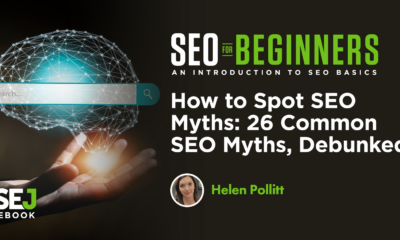How Facebook Ranks News Feed Posts

Facebook published an article that explains how the Facebook News Feed algorithm works. Compared with Facebook’s news feed algorithm patent, both documents explain much about how Facebook ranks posts in the news feed.
Machine Learning and Ranking
Facebook’s news feed algorithm is a machine learning ranking system. It’s not just one algorithm though. It’s a combination of multiple algorithms that work together in different phases.
Parts of the algorithm do different things, like selecting “candidate” posts to show in a person’s news feed, eliminating posts with misinformation or clickbait, creating lists of friends that a person interacts with, topics that the person tends to engage with and then using all of these factors to rank (or not rank) posts in a Facebook news feed.
All of those different layers are applied in order to predict what a Facebook member is going to find relevant to them.
The goal of the algorithms is to to rank which posts show up in the news feed, the order they are in and to select the posts that a Facebook member is likely to be interested in and to interact with.
It’s not just a few signals either that are considered. Facebook states that they use thousands of signals.
According to Facebook:
“For each person on Facebook, there are thousands of signals that we need to evaluate to determine what that person might find most relevant… to predict what each of those people wants to see in their feed…”
Facebook News Feed Ranking Signals
Characteristics of a Facebook Post
One of the ranking signals that Facebook discusses is the “characteristics” of a post.
Facebook is using a feature or quality of a post and determining whether this is the kind of thing that a user tends to interact with more.
For example, if a post is accompanied with a colorful image and a member has a history of interacting with posts with colorful images, then that’s going to be ranked higher.
If a post is accompanied by a video and that’s what a Facebook member likes to interact with, then that’s going to be ranked higher for that member.
Whether the post has an image, a video, if friends of a user are tagged in the post, those and other characteristics of a post are used as a ranking factors for determining whether a post is going to be shown to a user and how high it’s going to be ranked in the news feed.
Facebook used the example of a fictional user called Juan (the name “John” in Spanish) to illustrate the characteristics ranking factor.
This is what Facebook said about the characteristics ranking factor:
“We can use the characteristics of a post, such as who is tagged in a photo and when it was posted, to predict whether Juan might like it.
For example, if Juan tends to interact with Saanvi’s posts (e.g., sharing or commenting) often and her running video is very recent, there is a high probability that Juan will like her post.
If Juan has engaged with more video content than photos in the past, the like prediction for Wei’s photo of his cocker spaniel might be fairly low.
In this case, our ranking algorithm would rank Saanvi’s running video higher than Wei’s dog photo because it predicts a higher probability that Juan would like it.”
Time is a Facebook Ranking Factor
Facebook’s example that was noted above also illustrate how time, in the form of how recently something was posted, can also be used as a ranking factor.
What’s interesting about the example of the fictional “Juan” is that Facebook mentioned that when a post was made is a ranking factor.
“We can use the characteristics of a post, such as who is tagged in a photo and when it was posted, to predict whether Juan might like it.”
That aspect of time as a ranking factor coincides with a relatively recent Facebook patent that states that how recently something was posted can be used as a ranking factor.
The Facebook news feed patent is called, Selection and Presentation of News Stories Identifying External Content to Social Networking System Users.
This is what the Facebook News Feed patent says:
“…news stories may be ranked based on chronological data associated with interactions with the news stories, so that the most recently shared news stories have a higher ranking.”
That seems to confirm the value in posting the same post more than once during the course of a day. It may reach different people across time periods and those who interact with the post may help it to be shown to their friends, etc.
Engagement and Interest
Another ranking factor involves predicting whether a user will be likely to be interested in or engage with a post. Facebook uses a number of signals to make that prediction.
The article is clear on that point:
“…the system determines which posts show up in your News Feed, and in what order, by predicting what you’re most likely to be interested in or engage with.”
And some of those factors that Facebook uses are signals from past posts and people that the user has interacted with. Facebook uses these past interactions to help it predict what a user will interact with in the future.
According to Facebook:
“These predictions are based on a variety of factors, including what and whom you’ve followed, liked, or engaged with recently.”
Facebook uses machine learning models to predict each of these different things. There’s a model that predicts what content a user will like, another model that predicts which post the user will comment on.
Each of these forms of engagement receive a ranking score and are subsequently ranked.
To summarize, the ranking process begins by identifying candidate posts to rank, from a pool of posts that were made since the user’s last login.
The next step is to assign ranking scores to each post.
This is how Facebook explains it by using an example of a fictional user named Juan:
“Next, the system needs to score each post for a variety of factors, such as the type of post, similarity to other items, and how much the post matches what Juan tends to interact with.
To calculate this for more than 1,000 posts, for each of the billions of users — all in real time — we run these models for all candidate stories in parallel on multiple machines, called predictors.”
Ranking Signals are Personalized to the User
An interesting insight into ranking factors is that they are weighted differently from one user to the next. Weighted means for when a ranking signal is more important than another ranking signal.
What Facebook revealed is that for one person, the prediction that they would “like” a post could have a stronger influence on whether that post is ranked.
For another user, the prediction that the user will comment on a post is given a stronger ranking weight.
Facebook shared:
“Next is the main scoring pass, where most of the personalization happens.
Here, a score for each story is calculated independently, and then all 500 posts are put in order by score.
For some, the score may be higher for likes than for commenting, as some people like to express themselves more through liking than commenting.
Any action a person rarely engages in (for instance, a like prediction that’s very close to zero) automatically gets a minimal role in ranking, as the predicted value is very low.”
What that means is that in order for a post to be successful, the post must inspire different forms of engagement from every user.
Contextual Features for Diversity of News Feed
The last step in the ranking process is to ensure diversity of the type of content that is shown in the news feed. That way the user’s feed doesn’t become repetitive.
Multiple Personalized Facebook Ranking Factors
Facebook didn’t list every ranking factor used to rank posts in a news feed. But they did give an idea, an overview of how the ranking process happens and what kinds of behavior are prioritized. We also learned that ranking signals are dynamic and can be weighted differently depending on the person.
Citations
How Does News Feed Predict What You Want to See?
How Machine Learning Powers Facebook’s News Feed Ranking Algorithm
Sentiment Polarity for Users of a Social Networking System (PDF)
Re-Ranking Story Content (PDF)
Resolving Entities from Multiple Data Sources for Assistant Systems (PDF)
Facebook Faces Yet Another Outage: Platform Encounters Technical Issues Again

Uppdated: It seems that today’s issues with Facebook haven’t affected as many users as the last time. A smaller group of people appears to be impacted this time around, which is a relief compared to the larger incident before. Nevertheless, it’s still frustrating for those affected, and hopefully, the issues will be resolved soon by the Facebook team.
Facebook had another problem today (March 20, 2024). According to Downdetector, a website that shows when other websites are not working, many people had trouble using Facebook.
This isn’t the first time Facebook has had issues. Just a little while ago, there was another problem that stopped people from using the site. Today, when people tried to use Facebook, it didn’t work like it should. People couldn’t see their friends’ posts, and sometimes the website wouldn’t even load.
Downdetector, which watches out for problems on websites, showed that lots of people were having trouble with Facebook. People from all over the world said they couldn’t use the site, and they were not happy about it.
When websites like Facebook have problems, it affects a lot of people. It’s not just about not being able to see posts or chat with friends. It can also impact businesses that use Facebook to reach customers.
Since Facebook owns Messenger and Instagram, the problems with Facebook also meant that people had trouble using these apps. It made the situation even more frustrating for many users, who rely on these apps to stay connected with others.
During this recent problem, one thing is obvious: the internet is always changing, and even big websites like Facebook can have problems. While people wait for Facebook to fix the issue, it shows us how easily things online can go wrong. It’s a good reminder that we should have backup plans for staying connected online, just in case something like this happens again.
Christian family goes in hiding after being cleared of blasphemy

LAHORE, Pakistan — A court in Pakistan granted bail to a Christian falsely charged with blasphemy, but he and his family have separated and gone into hiding amid threats to their lives, sources said.
Haroon Shahzad, 45, was released from Sargodha District Jail on Nov. 15, said his attorney, Aneeqa Maria. Shahzad was charged with blasphemy on June 30 after posting Bible verses on Facebook that infuriated Muslims, causing dozens of Christian families in Chak 49 Shumaali, near Sargodha in Punjab Province, to flee their homes.
Lahore High Court Judge Ali Baqir Najfi granted bail on Nov. 6, but the decision and his release on Nov. 15 were not made public until now due to security fears for his life, Maria said.
Shahzad told Morning Star News by telephone from an undisclosed location that the false accusation has changed his family’s lives forever.
“My family has been on the run from the time I was implicated in this false charge and arrested by the police under mob pressure,” Shahzad told Morning Star News. “My eldest daughter had just started her second year in college, but it’s been more than four months now that she hasn’t been able to return to her institution. My other children are also unable to resume their education as my family is compelled to change their location after 15-20 days as a security precaution.”
Though he was not tortured during incarceration, he said, the pain of being away from his family and thinking about their well-being and safety gave him countless sleepless nights.
“All of this is due to the fact that the complainant, Imran Ladhar, has widely shared my photo on social media and declared me liable for death for alleged blasphemy,” he said in a choked voice. “As soon as Ladhar heard about my bail, he and his accomplices started gathering people in the village and incited them against me and my family. He’s trying his best to ensure that we are never able to go back to the village.”
Shahzad has met with his family only once since his release on bail, and they are unable to return to their village in the foreseeable future, he said.
“We are not together,” he told Morning Star News. “They are living at a relative’s house while I’m taking refuge elsewhere. I don’t know when this agonizing situation will come to an end.”
The Christian said the complainant, said to be a member of Islamist extremist party Tehreek-e-Labbaik Pakistan and also allegedly connected with banned terrorist group Lashkar-e-Jhangvi, filed the charge because of a grudge. Shahzad said he and his family had obtained valuable government land and allotted it for construction of a church building, and Ladhar and others had filed multiple cases against the allotment and lost all of them after a four-year legal battle.
“Another probable reason for Ladhar’s jealousy could be that we were financially better off than most Christian families of the village,” he said. “I was running a successful paint business in Sargodha city, but that too has shut down due to this case.”
Regarding the social media post, Shahzad said he had no intention of hurting Muslim sentiments by sharing the biblical verse on his Facebook page.
“I posted the verse a week before Eid Al Adha [Feast of the Sacrifice] but I had no idea that it would be used to target me and my family,” he said. “In fact, when I came to know that Ladhar was provoking the villagers against me, I deleted the post and decided to meet the village elders to explain my position.”
The village elders were already influenced by Ladhar and refused to listen to him, Shahzad said.
“I was left with no option but to flee the village when I heard that Ladhar was amassing a mob to attack me,” he said.
Shahzad pleaded with government authorities for justice, saying he should not be punished for sharing a verse from the Bible that in no way constituted blasphemy.
Similar to other cases
Shahzad’s attorney, Maria, told Morning Star News that events in Shahzad’s case were similar to other blasphemy cases filed against Christians.
“Defective investigation, mala fide on the part of the police and complainant, violent protests against the accused persons and threats to them and their families, forcing their displacement from their ancestral areas, have become hallmarks of all blasphemy allegations in Pakistan,” said Maria, head of The Voice Society, a Christian paralegal organization.
She said that the case filed against Shahzad was gross violation of Section 196 of the Criminal Procedure Code (CrPC), which states that police cannot register a case under the Section 295-A blasphemy statute against a private citizen without the approval of the provincial government or federal agencies.
Maria added that Shahzad and his family have continued to suffer even though there was no evidence of blasphemy.
“The social stigma attached with a blasphemy accusation will likely have a long-lasting impact on their lives, whereas his accuser, Imran Ladhar, would not have to face any consequence of his false accusation,” she said.
The judge who granted bail noted that Shahzad was charged with blasphemy under Section 295-A, which is a non-cognizable offense, and Section 298, which is bailable. The judge also noted that police had not submitted the forensic report of Shahzad’s cell phone and said evidence was required to prove that the social media was blasphemous, according to Maria.
Bail was set at 100,000 Pakistani rupees (US $350) and two personal sureties, and the judge ordered police to further investigate, she said.
Shahzad, a paint contractor, on June 29 posted on his Facebook page 1 Cor. 10:18-21 regarding food sacrificed to idols, as Muslims were beginning the four-day festival of Eid al-Adha, which involves slaughtering an animal and sharing the meat.
A Muslim villager took a screenshot of the post, sent it to local social media groups and accused Shahzad of likening Muslims to pagans and disrespecting the Abrahamic tradition of animal sacrifice.
Though Shahzad made no comment in the post, inflammatory or otherwise, the situation became tense after Friday prayers when announcements were made from mosque loudspeakers telling people to gather for a protest, family sources previously told Morning Star News.
Fearing violence as mobs grew in the village, most Christian families fled their homes, leaving everything behind.
In a bid to restore order, the police registered a case against Shahzad under Sections 295-A and 298. Section 295-A relates to “deliberate and malicious acts intended to outrage religious feelings of any class by insulting its religion or religious beliefs” and is punishable with imprisonment of up to 10 years and fine, or both. Section 298 prescribes up to one year in prison and a fine, or both, for hurting religious sentiments.
Pakistan ranked seventh on Open Doors’ 2023 World Watch List of the most difficult places to be a Christian, up from eighth the previous year.
Morning Star News is the only independent news service focusing exclusively on the persecution of Christians. The nonprofit’s mission is to provide complete, reliable, even-handed news in order to empower those in the free world to help persecuted Christians, and to encourage persecuted Christians by informing them that they are not alone in their suffering.
Free Religious Freedom Updates
Join thousands of others to get the FREEDOM POST newsletter for free, sent twice a week from The Christian Post.
Individual + Team Stats: Hornets vs. Timberwolves
CHARLOTTE HORNETS MINNESOTA TIMBERWOLVES You can follow us for future coverage by liking us on Facebook & following us on X: Facebook – All Hornets X – …
Source link
-

 SEARCHENGINES5 days ago
SEARCHENGINES5 days agoBillions Of Google goo.gl URLs To 404 In The Future
-

 SEO7 days ago
SEO7 days ago26 Common SEO Myths, Debunked
-
SEARCHENGINES4 days ago
Daily Search Forum Recap: July 22, 2024
-

 SEARCHENGINES6 days ago
SEARCHENGINES6 days agoGoogle Core Update Coming, Ranking Volatility, Bye Search Notes, AI Overviews, Ads & More
-

 SEO5 days ago
SEO5 days ago11 Copyscape Alternatives To Check Plagiarism
-

 SEO6 days ago
SEO6 days agoGoogle Warns Of Last Chance To Export Notes Search Data
-

 AFFILIATE MARKETING5 days ago
AFFILIATE MARKETING5 days agoThe Top 5 AI Tools That Can Revolutionize Your Workflow and Boost Productivity
-
SEARCHENGINES3 days ago
Daily Search Forum Recap: July 23, 2024















